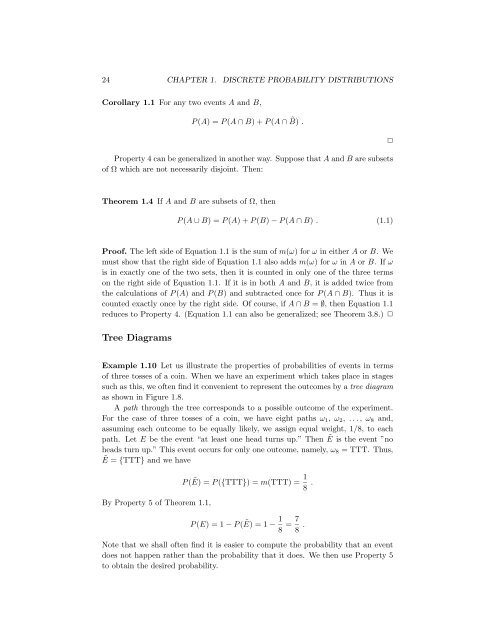Chapter 1 Discrete Probability Distributions - DIM
Chapter 1 Discrete Probability Distributions - DIM
Chapter 1 Discrete Probability Distributions - DIM
- No tags were found...
You also want an ePaper? Increase the reach of your titles
YUMPU automatically turns print PDFs into web optimized ePapers that Google loves.
24 CHAPTER 1. DISCRETE PROBABILITY DISTRIBUTIONSCorollary 1.1 For any two events A and B,P (A) =P(A∩B)+P(A∩ ˜B).Property 4 can be generalized in another way. Suppose that A and B are subsetsof Ω which are not necessarily disjoint. Then:✷Theorem 1.4 If A and B are subsets of Ω, thenP (A ∪ B) =P(A)+P(B)−P(A∩B). (1.1)Proof. The left side of Equation 1.1 is the sum of m(ω) for ω in either A or B. Wemust show that the right side of Equation 1.1 also adds m(ω) for ω in A or B. Ifωis in exactly one of the two sets, then it is counted in only one of the three termson the right side of Equation 1.1. If it is in both A and B, it is added twice fromthe calculations of P (A) and P (B) and subtracted once for P (A ∩ B). Thus it iscounted exactly once by the right side. Of course, if A ∩ B = ∅, then Equation 1.1reduces to Property 4. (Equation 1.1 can also be generalized; see Theorem 3.8.) ✷Tree DiagramsExample 1.10 Let us illustrate the properties of probabilities of events in termsof three tosses of a coin. When we have an experiment which takes place in stagessuch as this, we often find it convenient to represent the outcomes by a tree diagramas shown in Figure 1.8.A path through the tree corresponds to a possible outcome of the experiment.For the case of three tosses of a coin, we have eight paths ω 1 , ω 2 , ..., ω 8 and,assuming each outcome to be equally likely, we assign equal weight, 1/8, to eachpath. Let E be the event “at least one head turns up.” Then Ẽ is the event ”noheads turn up.” This event occurs for only one outcome, namely, ω 8 = TTT. Thus,Ẽ = {TTT} and we haveBy Property 5 of Theorem 1.1,P (Ẽ) =P({TTT}) =m(TTT) = 1 8 .P (E) =1−P(Ẽ)=1−1 8 =7 8 .Note that we shall often find it is easier to compute the probability that an eventdoes not happen rather than the probability that it does. We then use Property 5to obtain the desired probability.
















